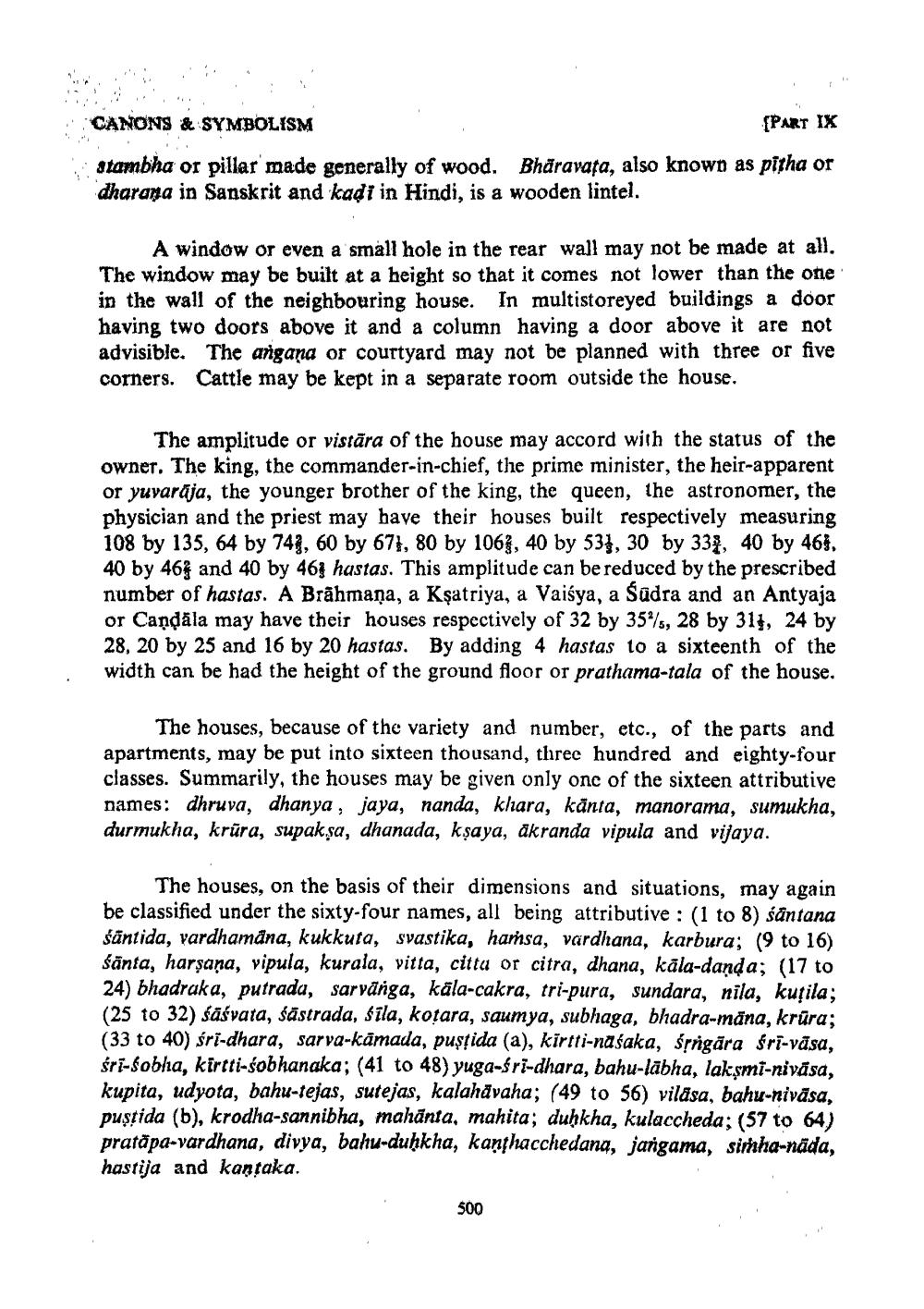________________
CANONS & SYMBOLISM
[PART IX stambha or pillar made generally of wood. Bhāravata, also known as pitha or dharana in Sanskrit and kadi in Hindi, is a wooden lintel.
A window or even a small hole in the rear wall may not be made at all. The window may be built at a height so that it comes not lower than the one in the wall of the neighbouring house. In multistoreyed buildings a door having two doors above it and a column having a door above it are not advisible. The angana or courtyard may not be planned with three or five Cattle may be kept in a separate room outside the house.
corners.
The amplitude or vistara of the house may accord with the status of the owner. The king, the commander-in-chief, the prime minister, the heir-apparent or yuvaraja, the younger brother of the king, the queen, the astronomer, the physician and the priest may have their houses built respectively measuring 108 by 135, 64 by 743, 60 by 671, 80 by 106, 40 by 531, 30 by 33, 40 by 46}, 40 by 46 and 40 by 463 hastas. This amplitude can be reduced by the prescribed number of hastas. A Brāhmaṇa, a Ksatriya, a Vaiśya, a Śūdra and an Antyaja or Candala may have their houses respectively of 32 by 355, 28 by 31, 24 by 28, 20 by 25 and 16 by 20 hastas. By adding 4 hastas to a sixteenth of the width can be had the height of the ground floor or prathama-tala of the house.
The houses, because of the variety and number, etc., of the parts and apartments, may be put into sixteen thousand, three hundred and eighty-four classes. Summarily, the houses may be given only one of the sixteen attributive names: dhruva, dhanya, jaya, nanda, khara, känta, manorama, sumukha, durmukha, krūra, supakṣa, dhanada, kṣaya, akranda vipula and vijaya.
The houses, on the basis of their dimensions and situations, may again be classified under the sixty-four names, all being attributive: (1 to 8) santana santida, vardhamana, kukkuta, svastika, hamsa, vardhana, karbura; (9 to 16) Santa, harṣaṇa, vipula, kurala, vitta, citta or citra, dhana, kala-danda; (17 to 24) bhadraka, putrada, sarvänga, kāla-cakra, tri-pura, sundara, nila, kutila; (25 to 32) śāśvata, sastrada, sila, kotara, saumya, subhaga, bhadra-māna, krūra; (33 to 40) śri-dhara, sarva-kamada, puṣṭida (a), kīrtti-nasaka, śṛngāra śrī-vāsa, śri-Sobha, kirtti-sobhanaka; (41 to 48) yuga-śri-dhara, bahu-labha, lakṣmi-nivāsa, kupita, udyota, bahu-tejas, sutejas, kalahävaha; (49 to 56) viläsa, bahu-nivāsa, puştida (b), krodha-sannibha, mahānta, mahita; duḥkha, kulaccheda; (57 to 64) pratäpa-vardhana, divya, bahu-duḥkha, kanthacchedana, jangama, simha-näda, hastija and kantaka.
500




